05 August, 2023
Lakeside Park, Kitchener, ON
Its tubers are eaten by some, raw, pickled or roasted, but as far as I know I have never had the pleasure.
Stickseeds (genus Hackelia) are interesting plants, several of which were growing at Lakeside Park.
I confess to being very fond of Chicory (Cichorium intybus) - not the extract used as a coffee substitute - but the glorious blue flower that dots the landscape of southern Ontario at this time of the year.
Wild Bergamot (Monarda fistulosa) has a bit of a "ragged" look about it, but is greatly favoured by pollinators of various kinds.
its common name derives from its pleasant fragrance, reminiscent of the Bergamot Orange grown in Italy.
Riverbank Grape (Vitis riparia) was used by early settlers to make jelly, but I suspect few people do this today.
It attracts a variety of birds, however, including Cedar Waxwing (Bombycilla cedrorum), Northern Flicker (Colaptes auratus) and even Pileated Woodpecker (Dyrycopus pileatus).
Greater Burdock (Arctium lappa) is the tallest representative of a group of plants that were the inspiration for Velcro.
Anyone who has ever been covered with burs at the end of a walk knows only too well how difficult they are to remove. Sadly, small birds (e.g. Golden-crowned Kinglet (Regulus satrapa)) are sometimes ensnared on the plant and die there.
One might be forgiven for concluding that Common Red Soldier Beetles (Rhagonyncha fulva) lead a life of orgiastic excess, since they seem always to be seen copulating, but this individual is taking a break from its hedonistic pursuits.
Wild Carrot (Daucus carota), otherwise known as Queen Anne's Lace, seems to be the host plant of choice for this species and the locus of their bacchanal.
Common Jewelweed (Impatiens capensis) sits ready to deliver copious volumes of nectar to hungry hummingbirds taking on fuel for migration.
July and August are the proverbial dog days for birders. Most species are busy with young, males have stopped singing, the foliage is at its densest and many species are undergoing moult.
Male Mallards (Anas platyrynchos) have been transformed by eclipse moult when they divest themselves of all their flight feathers at the same time, and are confined to the water for safety, and look for all the world like females.
Some, by now, are beginning to re-acquire their masculine splendour and various intermediate stages are on display.
I was impressed by the delicate beauty of the leaves of Staghorn Sumac (Rhus typhina), a familiar plant that rewards close inspection.
Common European Greenbottle Fly (Lucilia sericata) has had no trouble adjusting to life in southern Ontario.
I am sure that everyone is familiar with a paper wasp's nest (Polistes is Greek for 'city founder'), where the adults feed their young chewed up insects, especially larvae. They often patrol our backyard searching for caterpillars.
Hedge Parsley (genus Torilis) is very attractive.
This charming little bee is a Modest Masked Bee (Hylaeus modestus), a species that I had not seen before.
Wild Carrot sometimes takes on a pinkish hue.
Common Whitetail (Plathemis lydia) is one species of dragonfly that alights frequently and often close.
There were other species flying around that day, some quite big, but they never came within camera range or landed for even a second, so we have no pictures to share, nor do we know what we saw.
A Common Eastern Bumble Bee (Bombus impatiens) was contentedly nectaring on Wild Bergamot.
It was good to see native Narrow-leaved Cattail (Typha angustifolia) holding its own in the marshes, against the relentless onslaught of Common Reed (Phragmites australis).
Some of the Wild Carrot flowers are starting to form their familiar bird's nest shape, in many cases soon to be home to the larva of a Carrot Seed Moth (Sitochroa palealis), a site of both food and hibernation.
A Meadow Spittlebug (Philaenus spumarius) is responsible for the frothy foam seen on grasses, often referred to as Cuckoo Spit.
A Common Eastern Bumblebee was gathering pollen and nectar on Goldenrod (genus Solidago).
A Mock Strawberry (Potentilla indica) resembled the sort of protein spike we became accustomed to seeing on our TV screens during the height of COVID.
06 August, 2023
At Home, Waterloo, ON
Just as I was leaving to run some errands, a Monarch (Danaus plexippus) landed on the coneflowers at the front of the house.
In a flash, Miriam was there with her camera.
My young friend, Roddie, a self-confident boy (he is 12 years old) with naturalist blood running through his veins, has started his own blog. There are some great pictures there, so if you have a chance please drop by and take a look: https://rhornbyphotography.wixsite.com/the-waterloo-warbler
If you are able to leave a comment, I have no doubt he would appreciate a few words of encouragement.

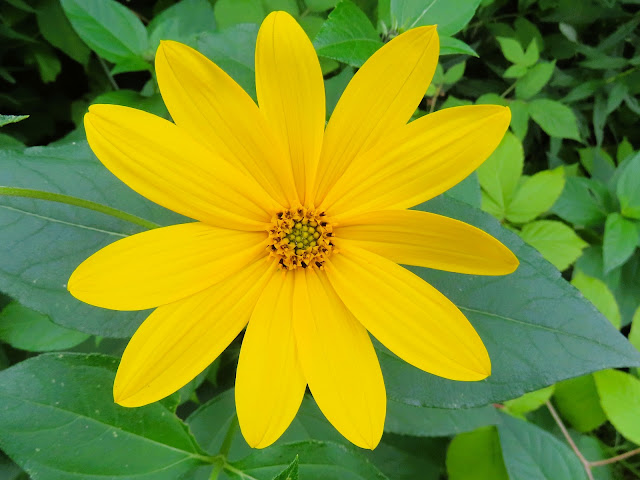









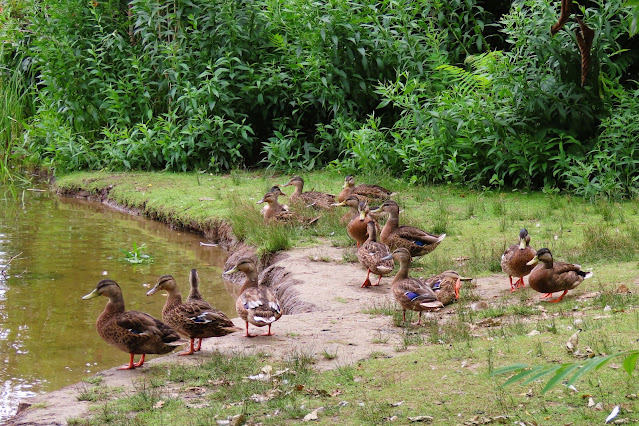










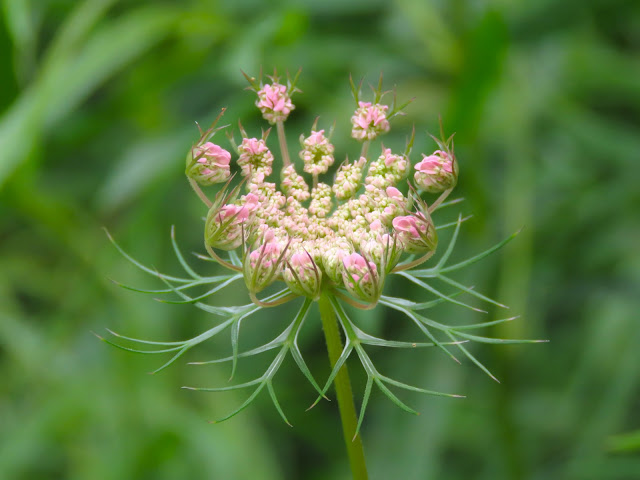
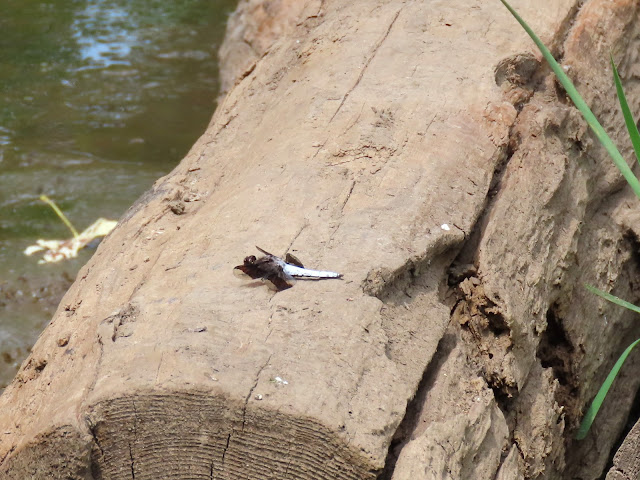




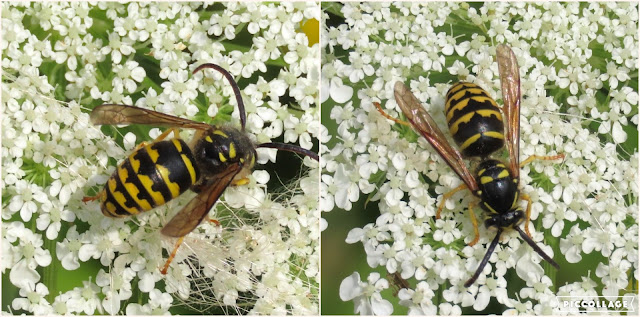
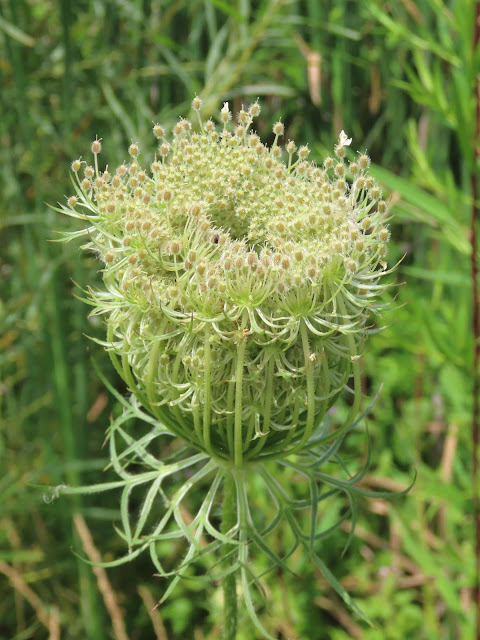






















Great place and lots of interesting things to see.
ReplyDeleteHari OM
ReplyDeleteWhat a wonderful ramble by the Lakeside... a true haven, no doubt about it. As for Jerusalem Artichoke - if you ever get the chance, do try it, David. They are delicious! YAM xx
Miriam did very, very well. Thank you both.
ReplyDeleteAnd thank you for sharing the joys around your area. I really, really need to learn more about insects. I appreciate their beauty but know too little about them.
Off to visit your friend Roddie now.
Sadly I couldn't find a way to comment on your friend's blog, but I was able to 'like' his post.
ReplyDeleteThanks, Sue. He’ll be happy to know you visited.
DeleteLoved looking at all the photos they are really lovely along with those flowers, all beautiful.
ReplyDeleteEse lago es muy refrescante. Todo es belleza en ese hermoso parque.
ReplyDeleteUn abrazo
...David, once again we didn't miss a detail. You are a fabulous botanist, entomologist and ornithologist, thanks for sharing the beauty.
ReplyDeleteThank you, Tom. You give me far too much credit.
DeleteYour knowledge always amazes me--along with all the wonderful photos, of course. :)
ReplyDeleteI do wish I had an area so diverse nearby. Of course, I do realize that part of the issue is that I'm not nearly as observant as I could be. There is likely more to see than I know.
ReplyDeleteThe monarch butterfly are so beautiful. Miriam did very well in capturing the images.
If you have a backyard you have a nature preserve right there.
DeleteI love all the beautiful flowers you show today. It's funny that you write about Monarda. I have many of these in different colors, but there is only one of them that smells really good. It is certainly a close relative of the one you show today.
ReplyDeleteI wish I had a visit from a Monarch butterfly here. You are so lucky to have it nearby. There are lovely pictures Miriam has taken of them.
Hugs and kisses, Marit
way to many stunning photos to pick a favorite. LOVE those ragged blues flowers and all yellow flowers are my favorite always. they are so joyful.. the butterfly by Miram are stunning. we call the river grapes, sea grapes. they grow both in the river and the sea and the swamp here, wild is what they are. we have a giant one in our back yard. years ago bob found a pice of one that looked lik a dead stick with 2 leaves on the end. he planted it not realizing it would become a TREE. i might do a post on that. it is huge. THEY say the grapes are edible, but I don't touch them
ReplyDeletePS thought of you this am, I had to throw a dishcloth on a small lizard on the kitchen floor, that is to keep from squishing her, she was only about 1 and 1/2 in long. as I carried her outside, a cricket hopped through the door and was hopping all over the kitchen. since i have lost many hours of sleep do to a trapped cricket in the house, i am soory to say he went to meet his maker with the fly swat.
ReplyDeleteKudos for saving the lizard, and you are forgiven for dispatching the cricket!
DeleteThe yellow flower is indeed glorious.
ReplyDeleteThe bees are in team work.
Miriam is an excellent photographer! The flowers and blooms are really pretty.
ReplyDeleteGorgeous nature and pictures !
ReplyDeleteHave a nice day !
Anna
The wild fires in Canada continue and it's tragic...
These wildfires are devastating.
DeleteFabulous photos, especially the last few of the coneflowers and butterflies, absolutely PERFECT! Hugs, Valerie xxxxx
ReplyDeleteOh my! I was excited even before I saw the Monarch Butterfly! That was the ‘icing on the cake’, as they say! Wonderful!
ReplyDeleteI agree - full marks to Miriam - the coneflower and the Monarch butterfly are picture perfect.
ReplyDeleteThe photos are absolutely beautiful. The close-up photos of the bees are incredible.
ReplyDeleteBeautiful shots!
ReplyDeleteYour series of nature photos are always very enjoyable. I don't think I have ever seen the mock strawberry before, or a few of the others. It is always very nice to be introduced to new things. Thank you David!
ReplyDeleteThis reminds me of our childhood rambles, finding so many fall flowers to and from school.
ReplyDeleteGood evening, dear friend! que tal? i am going to quote a passage that made me very funny, the humorous touch could go unnoticed: "There were other species flying around that day, some quite big, but they never came within camera range or landed for even a second, so we have no pictures to share, nor do we know what we saw." so funny! lol jajaj
ReplyDeletetoday's entry is a summer days dream... well, they all are actually. Flowers, subtle, delicate, flowers that enchant but also inspire and feed. Jelly and Velcro even another one that looks like Covid even! wow that's amazing.
Summer is already ripe in Ontario, the ducklings show it very clearly, what cute little things.
It is a beautiful park, I always learn a lot about nature here.
By the way, i'll visit Roddie's site. Greetings you from my southern winter to sunny Ontario.
Thanks for stopping by Roddie’s site, Carolina.
DeleteOh Burdock. It is the bane of my gardening experiences. I never had any until our last dog, who liked to go for walk-abouts in the woods, came home, more than once, with the burrs stuck all over him. Now burdock grows just about everywhere around the yard. It's hard to get rid of, and even though it has its role in nature, I get really tired of it. And most wildflowers I just let grow, and I've even bought goldenrod seeds. Enough of my grousing. You have some great photos, and I'm glad you had another successful and fun looking walk. hugs-Erika
ReplyDeleteOnce Burdock is established it’s a huge problem to eradicate it.
DeleteWonderful insect shots, so loving and respectful. And my favorite of all flowers, chicory. We have it along roadsides with Queen Anne's lace, making natural bouquets.
ReplyDeleteWonderful pictures. Thanks for the tour.
ReplyDeletehello David
ReplyDeletea foray through the flora and fauna, I wouldn't have thought of Corvid when I saw the wrong strawberry, but when I read it I had to agree with you, the butterfly is one of the most beautiful I've seen...
Greetings Frank
What a great series of photos these are David.
ReplyDeleteMy preference is for the Chicory and the last three pictures of the Monarch butterfly on the red coneflower, really great pictures.
Greetings from Irma
Hi David – well you've started me off again … I can see an artichoke post coming sometime. That chicory flower is just beautiful – lovely colour … also good to eat. You're giving us lots of interesting plants that have helped humans over the millennia – and thank goodness for the berries available for the birds.
ReplyDeleteThen velcro … we learn so much from nature … I can't get to like the drink dandelion-burdock. Well at least the beetle is holding off! Stunning photos – Miriam takes brilliant pictures for us – the Monarch ones are outstanding. I've visited Roddie and left a note … he's certainly enthusiastic. Cheers Hilary
The flavour of your blog posts seems to be gently changing, David, and becoming more all-embracing in subject matter - and I'm with you all the way. Miriam is also showing expansion of her photographic skills with some wonderful close-up shots of small creatures. I guess that some of this is being driven by a dearth of avian subjects, but I'm more than happy with the alternatives.
ReplyDeleteWe used to grow Jerusalem Artichokes in the erly days of our marriage and had them roasted with the 'Sunday roast lunch' when we had such things. Sunday roasts are now a rarity with us.
I have visited Roddie's site and left a comment. Such an eloquent young man, and budding naturalist - I see a great future for him.
Best wishes to you and Miriam - - - Richard
Thanks for stopping by to say hello to Roddie, Richard. I saw your comment and I share your concern about handling dragonflies, or anything else for that matter. We miss lots of stuff since it never lands, but we will never go out with the intention of capturing odenates, butterflies or other small creatures. Roddie took a day-long dragonfly course at the Guelph Arboretum, partly involving going out with nets to capture them, and I am sure, like all young boys there is an irresistible urge to handle them. We’ll have to work on it!
DeleteI'm always so impressed with the nature you are able to photograph. Then the knowlegde you pass on. Thank you so much. BTW I agree about going into the water. LOL
ReplyDeleteThat artichoke flower is lovely and I really love that raggy look of the bergamot. I'd like to grow that one. Your photos, as always,, are splendid and this is just a beautiful post. So nice to see many happy bees out there! I smiled at your description of that one red bloom (was that the mock strawberry?) as resembling Covid (it's baaack....). Very true!
ReplyDeleteThe chicory is so pretty. I would love to see them covering the landscape. What a sight that would be. I have never seen it in Hawaii.
ReplyDeleteDear David, you have a variety of beautiful plants in Lakeside Park - and many of them that can be used (as you also mentioned in part) for culinary purposes, as spices or for complete meals! We grow Jerusalem artichokes in the garden, the tubers are very healthy and a Jerusalem artichoke hazelnut soup is particularly delicious. We have also eaten the roots of the wild carrot - mixed with "normal" carrots and other vegetables. And we are already waiting for the ripening of the elder, from which we prepare compote and liqueur, and in the spring we eat the flowers in beer batter or make syrup from them.
ReplyDeleteI didn't know that male mallard ducks look like females after moulting, interesting! You also posted a lot of beautiful insect pictures - I am most happy about the dreamlike monarch butterfly.
All the best from Austria and have a nice weekend
Traude
🌼❤️🌼
PS: You wrote to me in your comment that there is often a lot of wild life to be observed in cemeteries. This also applies to the central cemetery - in addition to squirrels (which I have often seen) and various "city birds" there should also be deer and stags, badgers, martens, hedgehogs, field hamsters, rarer birds etc. to see. Unfortunately, there were just too many people present when we visited. We'd have to get there on a quiet day. But I can offer you a photo series from the Vienna Central Cemetery that you might like: https://www.heute.at/g/es-lebe-der-zentralfriedhof-und-alle-seine-tiere-100023902
I enjoy seeing the insects almost as much as the birds. I am noticing them more now, thanks to you and Miriam, David.
ReplyDeleteGlad that we aided in your conversion, Marie.
DeleteAll these colors and insects are a gift from nature.
ReplyDeleteI should make Jerusalem artichokes for dinner, they're good . It looks like parsnips.
The ducks are as prolific as the geese!
Love David
I grow Topinambour (Jerusalem artichoke) every year, we love it and it makes the most amazing soup, but it is good even raw in a salad. Some people complain it gives them wind, but we are lucky and it does not cause either of us a problem!! Worth trying if you get a chance.
ReplyDeleteGreat post with a bit of everything. I have never seen a Monarch butterfly!!
Keep well and best wishes to you both. Bisous mon ami, Diane
Another lovely post.
ReplyDeleteThat monarch really is beautiful.
All the best Jan
PS I'm off to visit Roddie's site :)
Hello David
ReplyDeleteI did visit Roddie's site and tried to leave a comment but I don't think it's published.
He's certainly taken some very nice photographs.
All the best Jan
I visited your friend's site and was unable to comment - I was able to like the post. Although I applaud your friend's photography and hope he has a wonderful future ahead of him, I winced a little at him handling the dragonflies. But he also reminded me of one of my cousins, who ended up becoming, not a naturalist, but an emergency room doctor. As for your post, I enjoyed the photography. I've had Jerusalem artichokes and to me they were OK. I don't seek them out but I know they are popular with many. One of our local famers markets sometimes sells them. Alana ramblinwitham.blogspot.com
ReplyDeleteI agree with you, but I have to think back to myself at that age where I wanted to handle everything.
DeleteHello David, to my surprise most of the plants and insects you show here are to be seen here in Belgium, Netherlands and other European countries. Are those plants and insects native to Canada as well? Than a special compliment for Miriam. The photos of the Monarch butterfly are just stunning. So lucky to have it vissit your garden. It is indeed one of the most beautyful butterflies to be seen. I vissited the blog of you young friend but was not able to publish my comment.
ReplyDeleteRegards,
Roos
I agree with Roos' comment, every time I read your blog I'm surprised by the amount of plants and animals that you see and show that are also in Spain. Some of them have been introduced to North America, some others are native there as well. Your walk near the lake seems to have been so nice, I love all the green and especially the little insects such as the dragonfly. I have eaten Jerusalem artichokes during my time in England, but it's an invasive species in certain areas of Spain, although here it blooms in Autumn, a bit later. I supposed they have adapted to the differences in climate.
ReplyDeleteI love monarchs so much! I once had the chance to breed them from chrysalis and I saw their metamorphosis right in front of my eyes.
Have a nice weekend! Greetings from Spain.
Hi David,
ReplyDeleteA great collection of nature shots. Beautiful flowers en insects! Beatifully captured!
i can spend hours looking at the miraculous picures of the monarch bytterfly on top of the Echinacea!!!
Happy weekend and say hello to Miriam
Maria
Your image of the thistle that sometimes entraps a small bird reminded me of a plant we saw on a very barren island in the Great Barrier Reef a number of years ago. The naturalist explained that the birds eat the flowers of the plant, which are very sticky, so sometimes the birds are captured and die; and they fall to the ground and fertilize the plant living in this very inhospitable place. A tight evolutionary loop: the bird eats the plant and the plant eats the bird. I doubt if this is the case with the example you gave as the soil in your part of Canada is some of the very best!
ReplyDeleteHave a good week… mae at maefood.blogspot.com
David, it's so nice to browse through your photos again. My vacation is almost over, and I'm coming back to sniff around here and there among the blogs I follow. It strikes me that much of what I see on your blog is also present here in the Netherlands. I find that quite amusing. Those butterflies, as well as flowers and plants. Oh, and those butterflies are truly amazing. Thanks for sharing.
ReplyDeleteI love seeing that mock strawberry up close and the Monarch of course! Beautiful wildflowers in your area now!
ReplyDeleteUn placer para mí ver todas las fotografías, Miriam es una gran fotógrafa. Abrazos para los dos.
ReplyDeleteThat Lakeside Park is a haven of diversity. Lovely pictures and that stunning Monarch butterfly landing on the coneflowers is truly iconic
ReplyDeleteI enjoyed looking at all the gorgeous photos.
ReplyDeleteMiriam certainly has a great eye.
Happy Sunday, David
What joy to see nature through your lens !
ReplyDeleteAll they are really beautiful photographs of the Nature. Thanks for to give us the oportunity to see the beauty of this natural área, all Green, with flowers and Life. It is so wonderful.
ReplyDeleteI have yet to see a monarch butterfly this summer. Mostly, I see skippers and swallowtails.
ReplyDeleteA hummingbird buzzed up to me while I was eating lunch on the deck yesterday. I think he was trying to tell me to put the feeder back out, so I did. I had taken it in during a really hot spell because the liquid got very warm and I feared it would be spoiled.
Jerusalem artichoke is available as a type of fiber supplement. Whether or not it is worth taking that way depends upon which expert you consult. I just read about it’s marketing on Wikipedia and the story is interesting.
According to some advice that I have received it is often a serious cause of flatulence.
DeleteThank you again for showing us how nature is wonderful.
ReplyDeleteSome critters and plants you show here are common in Italy too but, thanks to your descriptions, I can learn more about them.
Have a good week.
Wonderful post..Lots of flowers that are familiar to me but I never knew their names..You have a wonderful assortment of wild flowers..
ReplyDeleteThe Monarchs are starting to arrive..Always beautiful and fun to see,
What a great picture of the monarch butterfly!!....it looks gorgeous over that pale pinkish-violet color flower!........Abrazotes, Marcela
ReplyDeletePiękne widoki z łąk. Uwielbiam takie kwiaty w terenie i wazonie. dzika marchew tak cudnie pachnie. Miałam jej sporo na wystawie kwiatów jako dodatek.
ReplyDeleteMiriam zrobiła cudne zdjęcia motyla. To zupełnie jak bajka!
so much beauty :)
ReplyDeleteWhat a magnificent flower the Jerusalem Artichoke is.
ReplyDeleteI can also find some of the flowers in your photos here, like chicory or dandelions and Wild Carrot, the photo of the Aerial Yellowjackets on this flower is spectacular.
Fabulous Monarch Butterfly photos!
Those Monarch photos are excellent (please tell Miriam). How exciting to see this beautiful butterfly. Oh, and I love the blue Chicory flower as well. In some areas here there is an abundance of them and I just love them.
ReplyDeleteI have passed on your kind words to her, Carola.
Delete